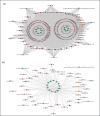Integrated analysis of microRNA and mRNA interactions regulating fecundity in the ovaries of two distinct sheep breeds
- PMID: 40745523
- PMCID: PMC12312324
- DOI: 10.1186/s12864-025-11408-0
Integrated analysis of microRNA and mRNA interactions regulating fecundity in the ovaries of two distinct sheep breeds
Abstract
Sheep production is vital to the global agricultural economy, particularly for meat and wool. However, fertility varies significantly among breeds, influenced by genetics, nutrition, and environment. MicroRNAs (miRNAs) are crucial post-transcriptional regulators of gene expression, binding to target messenger RNAs (mRNAs) to inhibit translation or trigger degradation. Despite their importance, little is known about ovary-specific miRNAs and their target genes in high and low fecundity sheep breeds. Here, we investigated miRNA expression profiles in ovarian tissues from Small Tail Han (high fecundity) and Dolang sheep (low fecundity) using miRNA sequencing. The analysis identified 51 significantly differentially expressed miRNAs (DEmiRNAs), with only nine mapping to the reference genome (including oar-miR-103, oar-miR-16b). We predicted 88,699, 176,629, and 240,753 target mRNAs for these DEmiRNAs from sheep, goat, and cow, respectively. Functional enrichment analysis revealed significant biological processes and signaling pathways potentially associated with fecundity. Subsequently, we constructed a DEmiRNA-mRNA regulatory network, highlighting candidate miRNA-mRNA pairs like chi-miR-130a-3p-WNT2B, oar-miR-103-FSHR, and oar-miR-16b-AMH. These findings provide insights into the potential regulators of sheep fecundity. We further validated these candidate miRNA-mRNA interactions using qRT-PCR to explore their roles in regulating sheep fecundity. Overall, this study utilized miRNA sequencing to analyze ovarian miRNA expression in sheep and identified potential miRNA-mRNA targets associated with fecundity. This lays the foundation for future research on the molecular mechanisms underlying sheep ovarian physiology and improving reproductive traits.
Keywords: Fecundity; Ovary; Ovine tissue; Sheep; Transcriptome; miRNA.
© 2025. The Author(s).
Conflict of interest statement
Declarations. Ethics approval and consent to participate: All the procedures involving animals were approved by the animal care and use committee at the Institute of Animal Sciences, Chinese Academy of Agricultural Sciences (NO. IAS2019-82), where the study was conducted. All the experiments were performed in accordance with ARRIVE guidelines and regulations set by the Ministry of Agriculture of the People’s Republic of China. Consent for publication: Not applicable. Competing interests: The authors declare no competing interests.
Figures









Similar articles
-
Comprehensive computational analysis of differentially expressed miRNAs and their influence on transcriptomic signatures in prostate cancer.Sci Rep. 2025 Jan 29;15(1):3646. doi: 10.1038/s41598-025-85502-4. Sci Rep. 2025. PMID: 39881138 Free PMC article.
-
Exploring the Mechanism of Acupuncture in Improving Ovarian Function in Rats with Poor Ovarian Response Using High-Throughput Sequencing.Comb Chem High Throughput Screen. 2025;28(8):1443-1457. doi: 10.2174/0113862073365843241223093834. Comb Chem High Throughput Screen. 2025. PMID: 39838669
-
Integrated Analysis of miRNA and mRNA Expression Profiles Associated with Development of Skeletal Muscle of Jiangquan Black Pigs.Genes (Basel). 2025 Jun 12;16(6):701. doi: 10.3390/genes16060701. Genes (Basel). 2025. PMID: 40565593 Free PMC article.
-
Deciphering the miRNA-mRNA Interaction Network Regulating Aging Skeletal Muscle in Various Exercise Regimens through Comprehensive Bioinformatics Analysis.Cell Biochem Biophys. 2025 Aug 1. doi: 10.1007/s12013-025-01848-6. Online ahead of print. Cell Biochem Biophys. 2025. PMID: 40748585 Review.
-
Comprehensive analysis of mRNA and miRNA expression profiles in follicular development in quail.Br Poult Sci. 2025 Aug;66(4):439-452. doi: 10.1080/00071668.2025.2451263. Epub 2025 Jun 2. Br Poult Sci. 2025. PMID: 40455599 Review.
References
-
- Souza CJ, MacDougall C, MacDougall C, Campbell BK, McNeilly AS, Baird DT. The Booroola (FecB) phenotype is associated with a mutation in the bone morphogenetic receptor type 1 B (BMPR1B) gene. J Endocrinol. 2001;169(2):R1-6. - PubMed
-
- Braw-Tal R, McNatty KP, Smith P, Heath DA, Hudson NL, Phillips DJ, et al. Ovaries of ewes homozygous for the X-linked Inverdale gene (FecXI) are devoid of secondary and tertiary follicles but contain many abnormal structures. Biol Reprod. 1993;49(5):895–907. - PubMed
MeSH terms
Substances
Grants and funding
LinkOut - more resources
Full Text Sources

